
Sex is a powerful tool that can be used to grab attention and generate excitement. But is it effective in advertising? Can it actually help to increase sales? In this article, we will look at examples of major brands that have used sex in their advertising, and see who has succeeded and who has failed.
Sex Sells: Examples of Successful Use of Sex in Advertising
Statistics indicate that advertising with sexual undertones can significantly enhance audience engagement. According to Nielsen research, commercials featuring elements of sexuality are 25% more likely to capture viewers' attention.
Old Spice
Once associated with a fragrance for the older generation, Old Spice revamped its strategy to attract the youth. In 2010, the brand launched a bold advertising campaign featuring a charming character, skillfully blending humor and sexuality to refresh its image.
By capturing the attention of the female audience with the promise that their partners could acquire an alluring scent with Old Spice, the campaign successfully won the hearts of young people. The uniqueness lay in the simplicity of content sharing on social media, leading to viral success and the creation of an online community around the brand.
This approach transformed Old Spice into not just a product but a cultural phenomenon, symbolizing modernity and attractiveness. Thus, Old Spice successfully reinvented itself, capturing the attention and loyalty of the younger generation.
Axe
Axe – a well-known brand of deodorant and shower gel – employed a similarly effective strategy. In every advertising campaign, they emphasized that the fragrance of their products not only eliminates body odor but also attracts women! Promising young men instant attention from women when using their deodorant, akin to an aphrodisiac, Axe quickly garnered the attention of its target audience: males aged 15 to 25.
Axe 'Even angel will fall'
This commercial is a masterpiece! Their tagline - Even angels will fall.
Tom Ford's Provocative Advertising Strategies
In the early days of his fashion reign, Tom Ford shocked the public with the provocative advertising of his first men's fragrance featuring a nude woman (2007). This bold move not only garnered attention but also brought tangible financial success, solidifying the fragrance's association with overtly sexual aesthetics.
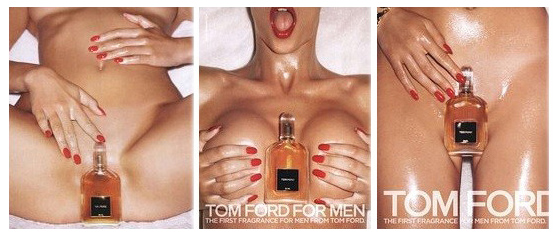
Over the subsequent years, Ford continued to incorporate explicit images in his advertising, but gradually, their frequency decreased. For instance, in 2010, he released an ad for his fall-winter collection featuring models in more modest attire.
This shift can be explained by several factors. Firstly, society became more tolerant of nudity.
Secondly, Ford himself adopted a more restrained approach in his expressions and behavior. Thirdly, he aimed to broaden his brand's audience and attract more conservative buyers.
Despite fewer nude depictions in Tom Ford's advertising, it remains provocative and memorable. Ford continues to employ bold images and ideas to draw attention to his brand.
Radiator Wetsuits: Improve your flexibility
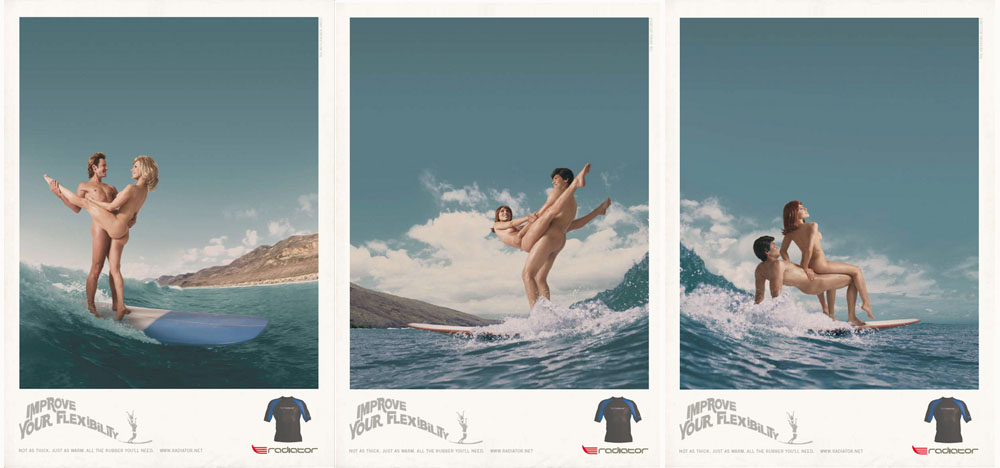
These captivating shots were featured in Australian Surf magazine to promote Radiator’s wetsuits. The provocative style and poses of the nude heroes in the advertisement caught the attention of surfers, which increased brand awareness. This approach represents a creative solution, complemented by the motivating slogan: "Improve your flexibility".
Sexual Accents in Alcohol Brands' Advertising Strategies

Leading alcohol brands like Heineken, Budweiser, Absolut, and Bacardi boldly incorporate provocative images where the atmosphere of pleasure intertwines with fun and enjoyment. Undoubtedly, this approach proves effective, capturing attention and establishing an emotional connection with the audience.
Calvin Klein's Embrace of Sexual Content in Advertising
Sexual content became a key element of creativity in Calvin Klein's advertising, not only attracting attention but also solidifying the brand's position in the fashion industry.
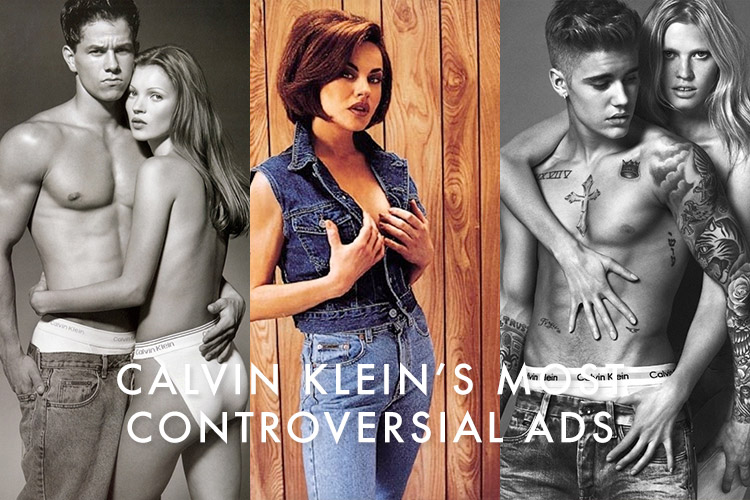
Kate Moss and Mark Wahlberg's 90s Ads
In the advertising industry, sexual models have become an effective tool for drawing attention to major clothing brands. Brands like Victoria's Secret adeptly use sensual images to promote lingerie, creating associations with a desirable lifestyle.
This trend extends beyond Victoria's Secret, with global giants like Reebok,
Dolce&Gabbana, and Armani also using sexual images to strengthen their positioning and attract their target audience. Sexual nuances in advertising create aesthetic appeal and can be decisive in shaping a brand's perception.
In the last five years, there's been an interesting trend towards using models with diverse physical characteristics. This inclusive practice in fashion advertising responds to society's demand for recognizing diversity and beauty in its various manifestations. Brands actively support this trend, aiming to create images that reflect the real diversity and beauty of the human body while emphasizing each individual's uniqueness.
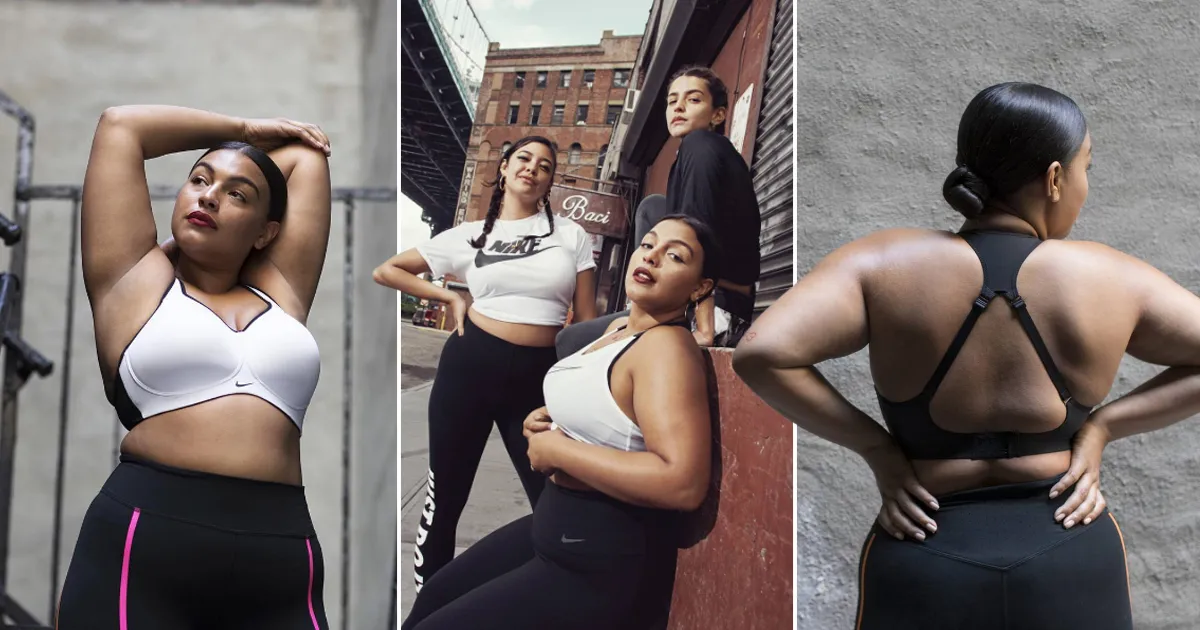
Scandalous Sex Advertising with Negative Consequences
Scandalous sexual advertising campaigns, full of provocations and provocative imagery, often lead to negative consequences for a brand. Disregarding socio-cultural norms and aiming to grab consumer attention sometimes results in serious repercussions for a company's reputation. It's crucial to note that effective advertising must strike a balance between creative approaches and respect for widely accepted moral standards.
Now let's explore a few examples of scandalous advertising that elicited a negative public reaction.
Suitsupply's Shameless Collection

Popular men's clothing brand Suitsupply launched a campaign in 2010 to promote its Shameless collection. The series of semi-nude and provocative images of women generated style but was placed in shopping centers, causing outrage among mothers with children. Some posts had to be removed from social media due to the highest dissatisfaction among women.
Lynx's Controversial Advertising

The Lynx brand in the UK faced criticism for its advertising, deemed too provocative by many. The social media ad featured a young man using Lynx products to attract a group of women, dancing and singing until one woman approaches and kisses him. The ad was criticized for objectifying women and depicting them as prey. Many found it offensive and demeaning.
This case illustrates how easily one can cross the line in advertising. Advertisers must be cautious not to use images or messages that can be perceived as offensive or demeaning.
A more explicit and provocative advertising format is perfect for placement on adult sites.
Why advertisers increasingly opting for adult traffic?
Protein World's Beach Body Controversy
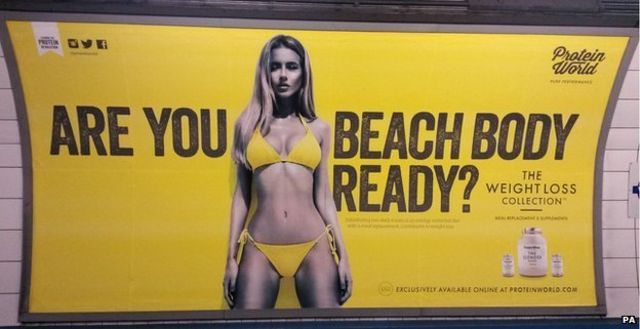
Protein World's advertisement depicting a bikini-clad model with the question "Is your body ready for the beach?" sparked massive outrage and accusations of body shaming. The company, specializing in sports nutrition, faced protests in London's Hyde Park, and a petition on Change.org gathered over 71,000 signatures expressing public dissatisfaction with the context and tone of the ad.
Carl’s Jr. “All Natural Burger”
In 2015, the American fast-food restaurant chain Carl's Jr. launched an advertising campaign for its new completely natural burger. The commercial aimed to be a memorable event that would boost the popularity of the chain. However, the number of people willing to visit Carl’s Jr. in the US dropped by 16%.
What was the reason for the failure? Women perceived such advertising as demeaning and offensive. The issue lies in the fact that women influence up to 80% of purchasing decisions. Therefore, advertising that neglects women's interests can be ineffective or even counterproductive.
As a result, the company abandoned the erotic strategy. The new campaign was named "Food, not boobs," and the videos released as part of the new approach mock the old one. Here's how they now advertise hamburgers:
All these examples underscore the importance of careful analysis and understanding of the values of the target audience before launching provocative advertising campaigns. A poorly chosen approach can lead to serious negative consequences for the brand.
Conclusion
Sex in advertising can be a powerful tool, but it's crucial to consider the characteristics of the target audience and the placement context. A balanced and creative approach to using sexual content can help not only attract attention but also strengthen the connection with consumers.
On the one hand, if your goal is a commercial on an adult site, then such advertising can be more provocative and expicit. On the other hand, TV advertising may only have a subtle sexual motive. In any case, it's important not to cross the fine line between sexual aesthetics and vulgarity, which can harm the brand's reputation.
Launch Ads with TrafficStars 🚀


 (1).jpg)
 (1).jpg)
.jpg)